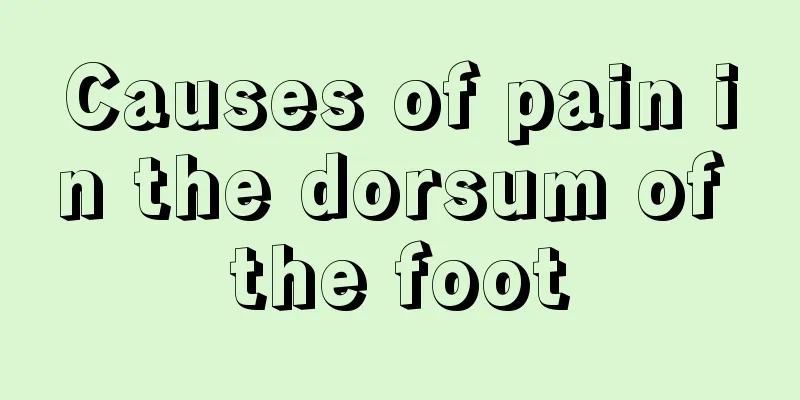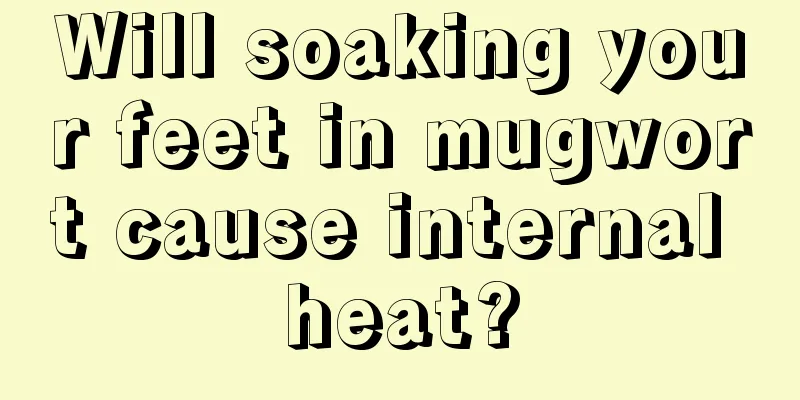Causes of pain in the dorsum of the foot

|
Cold starts from the feet, and the feet can be said to be our second heart. There are many acupoints distributed on the feet, and these acupoints correspond to the organs in our body. Therefore, we must also pay attention to the health of the feet. Some people experience pain in the dorsum of the foot, and there are many reasons for this symptom, such as friction between shoes and socks, excessive exercise... For pain in the dorsum of the foot, we can massage or soak the feet with Chinese medicine to relieve it. If the situation is serious, you need to go to the hospital in time. What causes pain in the instep? 1. Instep pain caused by arteriosclerosis As we age and our arteries harden, our blood supply becomes impaired. Once the climate changes and the weather gets colder, this impediment becomes more prominent, causing cramps in our hands and feet. This is the main reason why middle-aged and elderly people suffer from leg cramps in the middle of the night. High blood lipids. Because of high blood lipids, high blood viscosity, and slowed blood flow, it is more likely to get leg cramps in the middle of the night. 2. Instep pain caused by calcium deficiency Calcium deficiency is also a common cause. It is especially common in postmenopausal women. Once the body lacks calcium, not only middle-aged and elderly people, but even young people will suffer from cramps; cramps are likely to occur not only at night, but also during the day. 3. Pain in the instep caused by heart disease Especially people with heart failure will have cramps in their hands and feet aggravated. Because the nutrition of muscles throughout the body depends on the blood supply from the heart, if the heart is not functioning properly, the blood supply will of course be poorer. Cramps are a type of severe, painful muscle contraction (spasm), which usually occurs suddenly and violently, but does not last long, only a few minutes. The muscles are painful, stiff and tense to the touch, and muscle lumps or deformities are visible to the naked eye in the affected areas. The most commonly affected muscles are the peroneus muscles. 4. Pain in the instep caused by aponeurosis The plantar fascia of the elderly has poor elasticity and reduced function. If they run or jump vigorously, walk for a long time, or are exposed to cold and damp stimulation, inflammation is likely to occur. The prevention and treatment methods are that the elderly should not run or jump violently, wash their feet with hot water more often, and try to walk on tiptoe. If the condition is serious, ask the doctor to use local blockade with methylprednisolone combined with procaine. 5. Instep pain caused by Achilles tendinitis The Achilles tendon and its surrounding tissues are prone to non-bacterial inflammation due to trauma, excessive friction or long-term strain, especially when wearing small and hard leather shoes, and the heels of the shoes repeatedly rub against the Achilles tendon, which makes the disease more likely to occur. The method of prevention and treatment is to wear wide, soft cloth shoes, walk less, soak your heels in hot water more often, and rest for a few days to heal. What to do if you have foot pain: 1. Move your joints frequently. Move your fingers and toes, knees and elbows more often and do stretching exercises. This will drive away the deposits of uric acid crystals in the joints. 2. You can grind 5 grams of cinnamon into powder and take it with 20 grams of honey. Massage the joints and usually relieve pain in 30 minutes. 3. If the pain is really unbearable, you must use non-steroidal analgesics, such as diclofenac sodium. It is not possible to use hormones and salicylic acid to relieve pain, otherwise it will aggravate the condition. 4. Because the swollen area is hot and painful, you can apply an ice pack to the skin to help relieve the pain. 5. Choose shoes with thick soles, firm soles, and soft insoles. It is best if the heel has a certain curvature to accommodate the heel. 6. Another reason for foot pain from frequent shoe changes that perhaps no one has thought of is that it is caused by frequently wearing the same pair of shoes. Plantar warts are a virus that enters the skin through tiny cuts or friction points on the soles of the feet and grows inward, causing pain that feels like stepping on a nail. The virus that causes plantar warts loves warm, humid environments, and shoes fit the bill. Wearing the same pair of shoes every day will only make the shoes more and more humid. Changing shoes more often will help ventilate the shoes and promote the health of the foot skin. |
<<: What are the symptoms of wisdom teeth
Recommend
The difference between lead-mercury spots and chloasma
With the development of social economy, people pa...
What are the benefits of eating lotus pods
The most common food we eat is probably lotus roo...
What's going on with the urine smell down there_Why is there a urine smell down there
Female friends will experience many complications...
What is the solution to motion sickness?
I believe that everyone should have taken a car f...
Can pregnant women eat moxibustion licorice during pregnancy?
Pregnant women should be cautious in choosing foo...
How to improve oily hair? Rely on these six methods
The adverse effects of oily hair on people are hu...
What is the effect of albumin injection for liver cancer? Pay attention to these symptoms
What are the effects of albumin injection for liv...
Is lymphoma contagious?
For diseases like lymphoma, only timely detection...
What are the methods for treating endometrial cancer
We should learn more about the disease, only in t...
What can’t be eaten in crabs
The crab stomach, crab heart, crab gills, and cra...
What are the symptoms of heart paralysis and how to prevent it
The heart is the core organ in the human body, an...
What are the uses and effects of red wine?
As people's living standards improve, they pa...
Which is better, tampons or sanitary napkins?
Tampons are a foreign product introduced from som...
If hoarseness does not heal for a long time in winter, you should be alert to laryngeal cancer
Winter is the peak season for respiratory disease...
What are the benefits of zinc supplementation? There are so many effects
Calcium, iron, zinc and selenium are the four ele...









